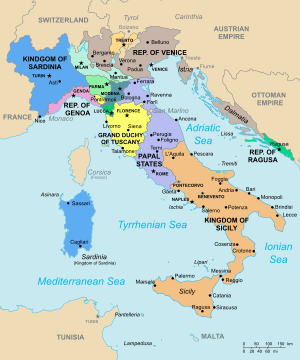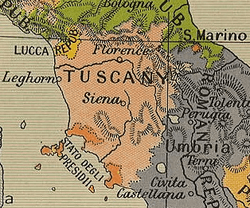Treaty of Aranjuez (1801)
The Treaty of Aranjuez (1801) was agreed on 21 March 1801 by France and Spain. It confirmed the terms of the secret Third Treaty of San Ildefonso dated 1 October 1800, in which Spain agreed to exchange its North American colony of Spanish Louisiana for territories in Tuscany.
Long name:
| |
|---|---|
Talleyrand; a versatile and subtle diplomatist, the Treaty was one part of a complex series of interlocking agreements | |
| Context | Confirmation of the Third Treaty of San Ildefonso; Spain agrees to transfer Spanish Louisiana to France for territories in Italy. |
| Signed | 21 March 1801 |
| Location | Aranjuez |
| Negotiators | |
| Parties | |
Background

Spain's alliance with France and the 1798-1802 Anglo-Spanish War resulted in a British naval blockade that severely impacted their economy. This was highly dependent on trade with its South American colonies, particularly the import of silver from Mexico.[1]
Louisiana formed the North-Eastern border of Spain's immense Empire in the Americas, which it had acquired relatively recently in the 1763 Treaty of Paris.[lower-alpha 1] Possession led to constant battles over illegal American activity in the Mississippi Basin, which was both costly and risked conflict with the US, whose merchant ships Spain relied on to evade the British blockade.[2]
After the November 1799 Coup of 18 Brumaire, the new government of First Consul Napoleon and his deputy Talleyrand made colonial expansion a key policy. Part of this involved the creation of a new French Empire in North America, with Louisiana as its hub.[3]
This combination of French ambition and Spanish weakness made an exchange attractive to both, preliminary terms being agreed in the secret October 1800 Third Treaty of San Ildefonso. In return for Louisiana, Charles IV's son-in-law Louis, Infanta Duke of Parma would be compensated for France's annexation of his inheritance, the Duchy of Parma.[4] Details were vague, Clause II stating 'it may consist of Tuscany...or the three Roman legations or of any other continental provinces of Italy which form a rounded state;' Spain would hand over Louisiana once this was confirmed.
Provisions

In February 1801, France and Austria agreed the Treaty of Lunéville, which included a provision awarding the Grand Duchy of Tuscany to France. The incumbent, Ferdinand III, was awarded the German territories of Archbishopric of Salzburg and Berchtesgaden in compensation.
Charles IV of Spain and his wife Maria Luisa persuaded her brother Robert Ferdinand of Parma to cede the Duchy of Parma to France.[lower-alpha 2] In return, the Treaty of Aranjuez made his son Louis King of the new Kingdom of Etruria, while Ferdinand was allowed to keep Parma until his death in October 1802.[5]
Etruria was composed of the Grand Duchy of Tuscany plus the Principality of Piombino although Talleyrand was distributing lands he did not yet control. In the Treaty of Florence of 28 March 1801, the Kingdom of Naples ceded Piombino and the State of the Presidi in southern Tuscany to France. The Presidi included Porto Longone on Elba which France retained, with the remainder then exchanged with Louis of Etruria for Piombino.[lower-alpha 3]
The transfer of Louisiana to France was officially confirmed in October 1802 when Charles IV announced it in a Royal Proclatation.[6]
Aftermath
This elaborate shuffling of Italian territories ultimately led nowhere; Etruria was dissolved and incorporated into France in 1807, while much of pre-Napoleonic Italy was restored by the Congress of Vienna in 1815, including the Grand Duchy of Tuscany and the Duchy of Parma.[lower-alpha 4]


Negotiations between France and Britain to end the War of the Second Coalition began in late 1801, resulting in the March 1802 Treaty of Amiens which brought temporary peace to Europe. In December 1801, a French army landed on the West Indian island of Saint-Domingue, which had become effectively self-governing under the rule of Toussaint Louverture; bringing it back into submission would be the first step in re-creating France's American empire.[lower-alpha 5]
Between 1798–1800, the United States and France fought an undeclared war at sea known as the Quasi-War, which was ended by the September 1800 Convention of 1800 or Treaty of Mortefontaine. French ambitions in North America concerned the United States; with Britain to the north in Canada, the US government much preferred a weak Spain to an aggressive and powerful France on its southern border.[7]
They were also aware France had conducted military surveys of Louisiana, including the Ohio and Mississippi valleys, to determine how best to defend it against US expansion if they regained control.[8] French ambitions seemed clear and the presence of over 30,000 veteran troops in Saint-Domingue meant they could enforce that policy.[lower-alpha 6] The US Ambassador to Spain, Charles Pinckney, was instructed to acquire Louisiana and the Floridas from the Spanish if possible but they denied any such deal had been agreed. It was not until February 1802 the Americans finally obtained details of the Treaty of Aranjuez from Rufus King, their envoy in London.[9]
However, by late 1802 it was becoming apparent that the Saint-Domingue expedition would likely end in failure, with Napoleon's brother-in-law, General Charles Leclerc dying from yellow fever along with many of his troops.[lower-alpha 7]. If Saint-Domingue were not brought back under French command, Louisiana would become much less relevant to France. With war against Great Britain likely to resume, Napoleon considered the possibility of selling the territory. Although France had pledged in the agreement with Spain not to transfer Louisiana to any other country, it sold the territory to the United States for $15 million in April 1803, one month before the resumption of war with the British.
Footnotes
- Their ally France ceded it as compensation for Spanish concessions to Britain elsewhere.
- Sic; the Bourbon and Habsburg aristocracy tended to re-use the same names, 'Ferdinand' and 'Maria Luisa' being particularly popular.
- At the time, Elba was occupied by the British.
- Although it was not until 1847 that the Bourbon Dukes of Parma regained their lands.
- The French action had the tacit support of many Americans, who feared the example set by Saint-Domingue to their own slaves.
- For comparison, in 1802 the US had no standing army, while the Navy consisted of 5,400 sailors and marines.
- An estimated 15,000 - 22,000 out of 30,000, many of them experienced and elite veteran soldiers.
References
- Sánchez, Rafael Torres (2015). Constructing a Fiscal Military State in Eighteenth Century Spain. AIAA. pp. 66 passim. ISBN 1137478659.
- Maltby, William (2008). The Rise and Fall of the Spanish Empire. Palgrave. p. 168. ISBN 1403917922.
- Kemp, Roger (ed) (2010). Documents of American Democracy. McFarland & Co. pp. 160-161. ISBN 0786442107.CS1 maint: extra text: authors list (link)
- Tarver, Micheal Hn (Author, Editor), Slape, Emily (Author, Editor) (2016). The Spanish Empire; An Historical Encyclopedia. ABC-CLIO. p. 53. ISBN 161069421X.CS1 maint: multiple names: authors list (link)
- Berte-Langereau, Jack (1955). "L'Espagne et le royaume d'Etrurie". Hispania. 15 (60): 353-460 passim.
- Real cédula expedida en Barcelona, a 15 de octubre de 1802, para que se entregue a la Francia la colonia y provincia de la Luisiana. Coleccion histórica completa de los tratdos, convenciones, capitulaciones, armistricios, y otros actos diplomáticos de todos los estados: de la America Latina comprendidos entre el golfo de Méjico y el cabo de Hornos, desde el año de 1493 hasta nuestros dias, Volume 4 (in Spanish). Paris. 1862. pp. 326–328.
- Kemp, Roger (ed) (2010). Documents of American Democracy. McFarland & Co. pp. 160. ISBN 0786442107.CS1 maint: extra text: authors list (link)
- Smith, James Morton (1956). Freedom's Fetters: Alien and Sedition Laws and American Civil Liberties (1966 ed.). Cornell University Press. p. 168. ISBN 0801490332.
- King, Rufus. "Madison Papers; To James Madison from Rufus King, 29 March 1801". Founders Archives. Original source: The Papers of James Madison, Secretary of State Series, vol. 1, 4 March–31 July 1801. Retrieved 2 July 2018.
Sources
- Berte-Langereau, Jack; L'Espagne et le royaume d'Etrurie; (Hispania Journal, Volume 15, Issue 30, 1955);
- Kemp, Roger (ed); Documents of American Democracy; (McFarland & Co, 2010);.
- Maltby, William; The Rise and Fall of the Spanish Empire; (Palgrave, 2008);
- Rodriguez,Junius P (ed); The Louisiana Purchase: A Historical and Geographical Encyclopedia; (ABC CLIO, 2002).
- Sánchez, Rafael Torres; Constructing a Fiscal Military State in Eighteenth Century Spain; (AIAA, 2015);
- Schneid, Frederick C; Napoleon's Conquest of Europe: The War of the Third Coalition; (Praeger/Greenwood);
- Smith, James Morton; Freedom's Fetters: Alien and Sedition Laws and American Civil Liberties; (Cornell University Press, 1966);
- Tarver, Micheal H & Slape, Emily; The Spanish Empire; An Historical Encyclopedia; (ABC CLIO, 2016);